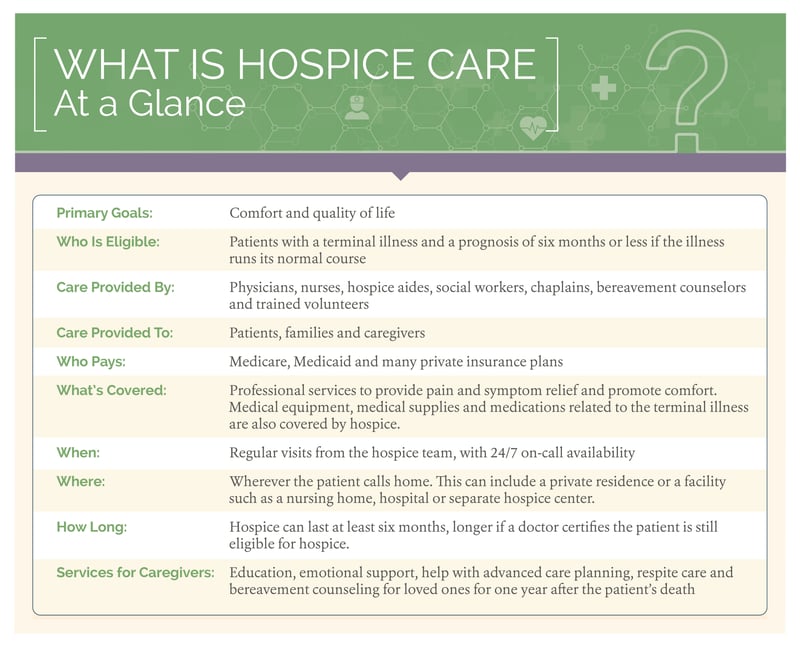When a loved one is diagnosed with a terminal illness, caregivers might begin to research the next steps for providing proper care. Hospice care is what most people want as they near the end of their lives. The primary goal is to provide comfort and quality of life while addressing the needs of families and caregivers. Plus, Medicare covers Hospice care at 100% for eligible beneficiaries.
Even with all the benefits of Hospice care, more than half of the people eligible don’t receive Hospice. This is largely because they don’t know what Hospice is or how it can benefit them and their loved ones.
So, let’s start there — what is Hospice care?

What Is Hospice Care?
Hospice is supportive care that focuses on comfort and quality of life for patients with a terminal illness and a life expectancy of six months or less if their illness runs its normal course, as certified by a physician.
Although not every case is the same, people often choose hospice when they aren’t expected to recover from a terminal illness or no longer wish to pursue aggressive treatments.
Hospice services include nursing care, home health aides, bereavement support, and other types of care. These services are provided by an interdisciplinary team of Nurses, Hospice Aides, Social Workers, Chaplains/Spiritual Counselors and Physicians.
What is Hospice care at home?
Patients can receive Hospice care from wherever they call home.
Depending on the level of care the patient needs, home can be a private residence, skilled nursing facility, assisted living community, other facility type, hospice center, or wherever the patient calls home. Some patients prefer hospice home care because they can receive services in the comfort of their own homes.
What is the purpose of Hospice?
The purposes of Hospice include:
- Helping patients live as well as possible, for as long as possible.
- Keeping patients comfortable during the end-of-life stages.
- Maintaining the best quality of life possible for the patient.
- Supporting caregivers and loved ones as they grieve.
- Helping patients identify what is most important to them and maximizing their ability to do those things.
What services are provided?
Hospice is a holistic approach that treats the whole person, addressing the patient’s medical, emotional, social, and spiritual needs. Each patient’s hospice care plan differs depending on their needs and what matters most to them. Some examples of hospice services include:
- Nursing care
- Help with bathing, dressing, and grooming from a Hospice Aide
- Medications, medical supplies, and equipment related to the hospice diagnosis
- Physical, occupational, and speech therapy
- Companionship from a volunteer
- Short-term inpatient care to manage pain and symptoms, if needed
- Respite care
- Dietary counseling
- Bereavement support
Hospice also helps family and caregivers. For example, the hospice team teaches caregivers how to provide day-to-day care. To ease the stress of caregiving, hospice offers respite care to give caregivers a break when needed. Additionally, hospice bereavement counselors help families through the grieving process after their loved one has passed.
How long is Hospice care?
Hospice care is provided to a wide range of patients with different conditions. Because of that, the length of hospice care varies depending on the patient. Although most Hospice care programs expect patients to stay six months or less, patients can receive care for longer than six months so long as they remain eligible. Understanding the different end-of-life stages can also determine the length of hospice care.
Patients who have a longer life expectancy or do not want to discontinue treatment to cure their illness may consider palliative care or home health care.
What Hospice Care is Not
Many myths about hospice care prevent people from getting their needs and wishes met. It’s important to know what hospice is, but it’s also important to know what hospice is not. For example:
- Hospice is not giving up hope or hastening death. In fact, it is quite the opposite. Hospice restores hope for a peaceful and meaningful last few months of life. It is about making the most of the time the person has left and keeping them as comfortable as possible. Many people use this time to build memories with family or find closure and peace.
- Hospice care is not only for people in their last few days of life. Because people think Hospice is for the final days of life, they wait too long to start care and receive only a fraction of the benefits. Patients can receive Hospice following a terminal diagnosis with a life expectancy of six months or less.
- When they see how life changes with added support, most families say they wish they had known about Hospice earlier.
- Hospice is not a place. Hospice is a service. This means Hospice can be provided wherever the patient calls home.
- Hospice is not just for cancer patients. Some other common illnesses among people in Hospice are heart failure, chronic obstructive pulmonary disease (COPD), liver or renal failure, dementia, and stroke.
Who Benefits From Hospice Care?
Hospice is for people with a terminal illness and a life expectancy of six months or less. Many hospice patients have conditions such as heart disease, cancer, COPD, or dementia.
A limited life expectancy doesn’t necessarily mean the patient will die within the next six months. It means that their doctor believes and has certified that, if the illness runs its normal course, the patient will live six months or less. During this time, Hospice care can provide numerous benefits to the patient and family.
Why do people choose Hospice?
First and foremost, Hospice care helps people remain in their home, where they feel safest and most comfortable.
The Hospice care team includes professionals with various skills who work together to meet the patient’s physical, emotional, and spiritual needs. These professionals work with the patient’s primary doctor and focus on managing pain and other distressing symptoms to provide comfort and a better quality of life. If needed, patients and caregivers can reach a team member 24 hours, seven days a week.
When a patient receives Hospice, their family or caregiver provides most of the day-to-day care. Hospice services include regular visits from Nurses, Hospice Aides, Social Workers, Chaplains, and trained Volunteers. This level of support can make it less likely the patient will have to go to the hospital.
When is Hospice recommended?
Among the many signs that it’s time for hospice, serious health challenges, a terminal illness diagnosis, or a recommendation from a primary care doctor are the clearest.
Is Hospice Care Covered By Insurance?
Hospice costs are generally 100% covered by Medicare, Medicaid, and many private insurance plans for eligible patients. Coverage includes:
- Professional services to manage symptoms and promote comfort
- Medications for pain and symptom management
- Medical equipment and supplies that help relieve pain and symptoms
Coverage does not include treatment or medications to cure the terminal illness or room and board in a nursing home or hospice residential facility.
Is Hospice Right for You?
Although this is a painful time and decisions feel difficult, help is available. As we’ve found with our own patients, many wish they had considered Hospice care sooner because of the enhanced quality of life and level of support received.
If you’re ready to take the next step, ask your loved one’s doctor if Hospice may be an option. Then, take our quiz to find out if Hospice care services would make their situation easier.





